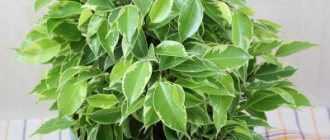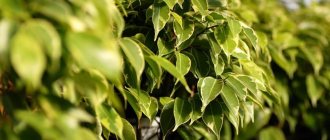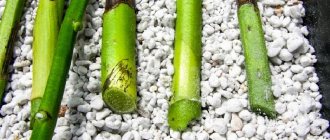Plants » Flowers
1
1976
Article rating
Kira Stoletova
Ficus Barok (barok ficus), or Ficus Baroque, is a unique plant. Today it is believed that this type of ficus belongs to the Benjamin family. Ficus Baroque grows quite slowly, although by its nature it is considered a very unpretentious plant. The flower got its name because of its rather extravagant and unusual leaves: they curl into an arc.
Ficus Baroque
Ficus Barok: tips for care, propagation and replanting
Ficus is an amazing plant with an amazing variety of species and varieties that today we can grow simply at home. So Ficus Barok ( Ficus Barok ) is a pearl among them, one of the varieties of Benjamin, and can rightfully be called the most unusual.
It's all about the bizarre shape of its leaves, which look twisted due to the arched vein. In addition, each leaf has a glossy, leathery green upper plate and a more faded lower plate, as well as smooth edges. They grow from 3 cm to 4 cm in length, and up to 2 cm in width. Each leaf has a dense, straight petiole. Ficus Baroque, although it grows slowly, still tries to do so rapidly. However, due to the fact that the trunk and side shoots are weak and thin, the crown, in general, looks rather sparse. But flower growers have found a solution to this - they plant several (2-3) ficuses in one pot. Then not a lonely tree grows, but a lush and curly bush, which will simply become an indispensable addition to any interior. Ficus Baroque photo
Ficus dwarf (creeping, pumila) - f. pumila
This species has climbing, creeping shoots with small, leathery, oval-shaped leaves from 2.5 cm in length to 1.5 in width. It has the ability to stick to almost any surface. The shoots of adult plants are lignified. Grows well in bright, full sun conditions.
Often grown as a hanging plant.
The main varieties in indoor floriculture:
- Sunny - has an uneven thin white stripe along the edges of the leaves.
- White Sunny - with a wide white or cream border along the edge of the leaf.
- Dort (Dorte) - this variety has leaves covered with white or cream spots.
Caring for ficus Baroque at home
In general, the ficus itself is not very demanding to handle, including the Ficus Benjamin Baroque. But in order for the plant to please you with its appearance, and not cause you worries, you need to follow simple rules that determine the correct care for it.
- Lighting : loves bright, diffused light. However, in order to protect the plant from burns on a hot summer day, it needs to be shaded from direct sunlight.
- Temperature : in summer, the most optimal temperature will be +23°C - +25°C. In winter, Barok likes moderate warmth - +12°C - +15°C.
It is worth remembering that Ficus Baroque is very sensitive to sudden changes in temperature and can react to irritation by dropping leaves.
- Watering : this ficus likes more or less abundant watering in spring and summer, and reduced in winter. But do not overwater the plant; its soil must dry out to about 2 cm deep before you water it again.
- Air humidity : Baroque can tolerate dry air quite well - this is very important especially in winter, when there is not enough humidity due to radiator heating. And yet the plant will respond gratefully to spraying.
It is important to know that dry air can cause spider mites to appear. Due to the unusual shape of the Baroka leaf, you risk not noticing this pest. To protect your plant, you need to wash it in the shower once every 1-2 weeks, or even better, immerse the crown in warm water for 3-7 minutes.
- Replanting : young plants are recommended to be replanted every spring, and more mature ones - once every 1-2 years. And sometimes, instead of replanting, you can simply change the top layer of soil.
- Fertilizing : fertilizing ficus with curly leaves is done with organic and mineral liquid substrates, 2 times a month during the period of active plant growth.
- Reproduction : like other varieties of Benjamin, Baroque can be propagated by cuttings, however, there are cases of propagation by seeds. Particularly skilled flower growers can do this with air layering.
And so we met another variety of ficus Benjamin, which surprised us with its unusual appearance. Ficus Baroque can become an exotic highlight in your home and complement your home green “collection”.
Watering
If we talk about watering the ficus, we can say this in one sentence: it requires attention. Don't just water it after a certain period. Take the time to assess the condition of the soil with your finger. Bury it a little into the ground (2-3cm) - is the soil stuck? – then it’s still early. Ficus needs to be watered as needed. But between waterings the soil should dry out a little. Over-watering is especially dangerous in winter. You also need to water it only with warm (and sometimes very warm) water.
There are types of ficus (ampeloid) that require more moisture than tree-like ones. These are Ficus mountaina, Ficus dwarf, Ficus arrow-shaped, Ficus ivy. It’s just that their root system absorbs water faster. But spraying and showering are useful for ficuses. Just be sure to take soft and warm water.
general description
Ficus Benjamin "Baroque" belongs to the Mulberry family.
Distributed throughout the world from China, India, Australia and Thailand.
It differs from other ficus trees by being more tree-like and having smaller leaf sizes.
The tip of each leaf forms a trench for water to drain.
This adaptation was formed in the plant due to frequent rains in its homeland.
Ficus Benjamin "Baroque" is highly valued in the gardening community.
It is unpretentious and easily amenable to changes by breeders who have bred species with different sizes, shapes and leaf colors.
Growing this plant will be easy even for beginners.
Home care
Care after purchase
Purchase soil suitable for this plant from a specialty store. This can be a substrate for ficus and palm trees.
Pay attention to the acidity of the soil. It should be pH=5-6.
Buy a suitable sized clay or ceramic pot.
Place expanded clay drainage on the bottom, which should occupy one quarter of the pot. Now you can start transplanting the ficus into a pot.
During the first few months, monitor the plant's acclimatization.
Yellowing and dropping leaves, drying out roots are a bad sign.
To do this, you need to change the watering or fertilizing regime, temperature or lighting.
Watering
Follow certain rules when watering your ficus:
- Excessive soil moisture harms the plant;
- Watering is carried out only when the top layer of soil dries 2 centimeters;
- In winter and when the temperature drops to 16-19 degrees Celsius, watering should be done little by little;
- At temperatures below 16 degrees Celsius, watering should be stopped completely;
- The use of hard water for irrigation is not allowed.
The water should be at room temperature or slightly warmer.
Bloom
Ficus benjamina blooms extremely rarely in apartments. This usually occurs in greenhouses or open areas.
The ficus inflorescence consists of small spherical berries, hollow inside.
Their color ranges from pale green to deep orange.
Crown formation
Due to the intensive growth of ficus in the spring months, it is necessary to form its crown at this time.
This procedure is not only useful from an aesthetic point of view, but also rejuvenates the plant.
The best tool for pruning is a pruning shears, previously disinfected with alcohol or potassium permanganate.
Trim all main shoots to 20 cm. Make sure each shoot has 5 or more leaves.
All cuts should be made above the kidney.
After completing the procedure, carefully wipe all sections with a dry cloth and sprinkle with crushed charcoal.
Ground and soil
The soil for ficus should be neutral or slightly acidic. Preferably fertile.
You can purchase a substrate for ficuses in specialized stores or prepare the soil yourself (for the preparation recipe, see the “Care after purchase” section).
Drainage should consist of an expanded clay bottom layer and a sand top layer.
Planting and transplanting
For planting and replanting, use a suitable size pot made of clay or ceramic. Repot every year between February and March.
In this case, you should increase the diameter of the pot by 4-5 cm. If this value already exceeds 30 cm, you should change 3 cm of the top soil, adding up to 20 percent organic fertilizer.
Reproduction
To start propagation, select a cutting with the most developed integumentary tissue. Carefully cut it off with a knife.
The resulting cutting should be 10-15 cm in length.
After cutting, it will secrete juice for about a day, so the water must be changed every 2.5 hours.
After 3 weeks, the cuttings , which have taken root, are transplanted into a separate pot.
Temperature
The optimal temperature for ficus "Baroque" differs in summer and winter.
In summer it is 20-25 degrees.
In winter , this value drops to 16-19 degrees, provided that the frequency of watering is reduced.
The plant safely tolerates temperatures below 16 degrees in the absence of watering.
Temperatures that are too high or too low can cause disease or death of the plant.
In the photo Benjamin's ficus "Baroque" (Baroque):
How to propagate
Ficus can be propagated in various ways: stem and apical cuttings, air layering, buds and leaves. However, the method of propagation depends on the type of ficus. When reproducing, we choose the desired method.
Propagation by cuttings.
We cut the cuttings at the beginning of spring; it should have two or three leaves. In other words, it should be a top cutting with a growing point. You need to dry the cut of the cutting and wait for the milky juice to come out of the cutting.
To root cuttings we use sand or expanded clay. The end of the cutting can be treated with root or another stimulant. Cover the container with cuttings with a bag or plastic bottle - you need to create greenhouse conditions.
Maintain constant humidity and place in a bright and warm place. Try to avoid direct sunlight. You can also use water to root cuttings; they root well in water, the main thing is to change it constantly. After a month, roots will begin to form on the cuttings. A ficus cutting will give roots faster if it is treated with rootstock.
Leaf propagation.
The process of propagation by leaf or bud is almost similar to propagation by cuttings, only the cutting is cut into parts, each part must have a bud or leaf. The sheet must be rolled into a tube and stuck into the sand. Carefully insert the peg into the hole made by the twisted sheet. For better rooting, before planting, you should carefully split the cut of the cutting and insert a grain of sand or pebble.
Reproduction by layering.
Adult ficus trees, which have grown in height and exposed trunks, are rejuvenated with the help of layering. To do this, in the spring you need to wrap the trunk with the shoot that you want to propagate by layering, cut it and cover it with damp sphagnum or peat.
To keep your structure in place – a place with moss or peat – wrap it in film and tie it with twine. Maintain constant humidity. The tied fragment should be tight enough so that it does not move out. Monitor the humidity and moisturize if necessary.
After a month or two, you can remove the moss and film and new roots will form at the site of the cut. We make a cut, which we then treat with charcoal; the resulting shoots with roots are planted in separate containers.
The ficus itself, from which we took layerings, is being transferred to a regime of careful care. We water it rarely, spray it, and then new shoots will appear from the dormant buds. With the emergence of new shoots, watering can be increased.
Diseases and pests
Diseases
The most common disease of ficus is anthracnose.
When it occurs, the leaves dry out and become covered with brown spots.
To get rid of this disease, the plant should be treated with preparations containing copper and watering should be reduced.
As a result of excessive watering, a grayish coating may appear on the leaves of the plant.
This disease is called botrytis.
In case of disease, place the ficus separately from other plants, remove damaged parts of the leaf and reduce watering.
Pests
Most often, the health of ficus is threatened by the following pests: scale insects, spider mites, aphids and mealybugs.
They are removed mechanically and using insecticides.
Benjamin “Baroque” at home, it will grow beautiful and healthy and will bring great benefits.
If you find an error, please select a piece of text and press Ctrl+Enter.
What Ficus Benjamin brings to the house: signs and superstitions
There are many superstitions associated with Ficus Benjamin. If in the East this plant is considered to be a symbol of wealth and prosperity, then in Russia and the CIS countries the ficus is called “muzhegon” and is credited with magical properties that have a negative impact on family members.
In China, Ficus Benjamin is given as a wedding gift and passed on from one generation to another, and in some Eastern countries this beautiful tree is considered sacred. At home, ficus is able to absorb negative energy, attract wealth into the house and help in amorous matters. If you give Ficus Benjamin to a childless couple, they will soon have a child.
But in order for this tree to have a positive effect on the “weather in the house”, it must be placed correctly:
- Kitchen - wealth and relief from financial problems.
- Office - good luck at work and increased productivity.
- Bedroom – improved sleep, relief from anxiety and quick pregnancy.
You should not place a pot of Ficus benjamina on the north or west side of the house. Then the plant will not have enough sun, and it will not be able to influence the microclimate in the family.
In any case, everyone decides for himself whether to believe or not to believe in various superstitions. But in any case, if this beautiful and lush tree appears in the house, the room immediately transforms and becomes more comfortable.
Ficus
In apartments, houses and offices, ficus is perhaps the most common plant that can decorate any interior. This plant has more than 900 species, and grows naturally in countries where tropical and subtropical climates predominate. Breeders have been able to develop varieties suitable for indoor growing, the most popular of which is Ficus Benjamin. These are miniature trees, shrubs and even vines with different types of leaves from lobed and solid to pubescent and glossy.
Flower design
Among the many types of ficus, you can find one that suits you; each type has different varieties. When creating a composition, you can use one type of ficus, combining different varieties. Or supplement it with suitable plants, which will be selected in such a way that the growing conditions are similar to those for ficuses.
Depending on the type of growth, the ficus can be placed in a floor planter, if it is tall and branchy, there are species that can be grown in hanging planters or placed on window sills or stands.
Having chosen one or another type of ficus, you can well select other plants for the composition; you can use it as a single plant and focus on a certain part of the interior in your home. In any case, ficus is an ideal plant for your interiors. Good luck to you.
Home care
Features of ficus care include creating an optimal environment, which depends on the level of light, temperature and humidity. Ficus places great demands on the amount of light in the room. If there is not enough of it, the leaves begin to curl, and the plant withers and loses its decorative appearance.
Video - Reproduction of Ficus Benjamin
Watering It is recommended to water the plant with warm water. The quantity should be such that the liquid begins to seep into the pan. After it has stood for some time, the water is drained. The next watering is carried out when the substrate dries 2-3 cm.
Humidity Loves humidity, so it definitely needs spraying. But in order to avoid white streaks remaining on the leaves, it is best to use settled, soft and slightly warm water.
Temperature Ficuses are heat-loving representatives of the tropical world. They immediately respond to a drop in temperature by dropping leaves. They also don’t like drafts.
Replanting Adult plants are replanted once every 5 years. If a ficus is purchased in a store, it needs several days to adapt to the indoor environment, and only then can it be transplanted. The optimal composition of soil for ficus is humus, peat and leaf soil taken in equal parts.
Feeding The plant responds well to the application of organic fertilizers, so it can be fed with diluted manure. The compositions that are sold in stores are also suitable: “Giant”, “Palma”, “Rainbow”.
Rest period
The biggest concern that novice ficus breeders experience is why it dropped almost all its leaves in the fall. And this is his natural feature. Almost all types of ficus, from October to February, have a dormant period: these flowers simply do not have enough light and warmth. But if you don’t want to wait every year for a bare bush to be covered with leaves in the spring, provide it with additional lighting and warmth in winter.
And only ficus-figs do not need to be forced to strain. After all, only after a period of dormancy can it bloom and bear fruit. It needs low temperatures and darkness.
Ficuses are also excellent flowers for forming bonsai. You can make a work of art from an ordinary bush. To do this, you need to shape the ficus crown. But that's a completely different story.
That's all the wisdom. Now you don’t have to wonder “how to care for a ficus . By following all these tips, you will achieve active growth and expansion of your indoor ficus. I wish you success!
Ficus species
Rubber plant (Ficus elastica) A young ficus has one trunk that stretches upward and is overgrown with leaves on all sides. The leaves of the rubber ficus are large, elliptical in shape with a dense waxy skin. A characteristic feature of this tree is the ability to form a banyan tree. After just a few years, “aerial roots” begin to stretch from the ficus shoots, which easily take root when they reach the substrate and form additional trunks.
Ficus rubbery (Ficus elastica) © Alvesgaspar (talk)
Benjamin (Ficus benjamina) This species includes many varieties, which may differ in the size and color of the leaves, which, as a rule, have a round shape. The trunk of Ficus Benjamin is covered with thin bark. This plant is easily formed into a bonsai, which makes it attractive for indoor floriculture.
Ficus benjamina
Benedicta (Ficus Binnendijkii) Used to decorate interiors in spacious rooms. The ficus trunk is long, not thick. The leaves are elongated, powerful, heavy, so most often a support is installed next to the trunk and the plant is tied to it so that it does not bend or break.
Ficus Benedict (Ficus Binnendijkii) © Nadiatalent
Bengal (Fícus benghalénsis) At home, this is a charming banyan tree with a lot of “aerial roots”, evergreen and very decorative. In nature, Ficus Bengal forms entire groves, growing several kilometers wide.
Ficus benghalensis © Forest and Kim Starr
Dwarf (Ficus pumila) A very beautiful, but demanding plant with green, small, dense leaves and a large number of “aerial roots” that can both take root in the soil and cling to supports and stretch along walls. Requires constant moisture and regular watering.
Ficus dwarf (Ficus pumila)
Lyre (Ficus lyrata) An evergreen ornamental tree that can grow to impressive size and requires a lot of indoor space. Does not tolerate proximity to other indoor crops. The leaves are large, wavy with many veins creating an original pattern.
Ficus lyrata
Curly ficus *
- Login to the forum to reply
#1 Dina
Not in the thunder of a cosmic catastrophe, not in the flames of atomic war, and not even in the grip of overpopulation, but in a well-fed, calm silence, the history of mankind ends. (A. and B. Strugatsky)
- Top
#2 fun_cruiser
- Top
#3 Natali
- Top
#4 Margita
New leaves grow much larger than “store-bought” ones and become less “curly.”
- Top
#5 Natali
Before selling it, they give it a marketable appearance, wrap it in curlers, and then - ::) :-X :-[
- Top
#6 Dina
Not in the thunder of a cosmic catastrophe, not in the flames of atomic war, and not even in the grip of overpopulation, but in a well-fed, calm silence, the history of mankind ends. (A. and B. Strugatsky)
- Top
#7
His name is Baroque (or Baroque? . Sorry, I forgot :-[. The girls will tell you :-*).
- Top
#8 Dina
Not in the thunder of a cosmic catastrophe, not in the flames of atomic war, and not even in the grip of overpopulation, but in a well-fed, calm silence, the history of mankind ends. (A. and B. Strugatsky)
- Top
#9 Daniel
- Top
#10 Net
- Top
#11 Dina
Hm. Net is right. They answered me. They write that a constant temperature of 18-22 is desirable, high humidity, very good lighting, but no direct sun, abundant watering, but not allowing stagnation of water, i.e., good drainage and the pot should also not float in water in the pan. It is better to feed with natural compost (which they sell in bottles, but I think I’ve seen it here too). This Baroque's leaves straighten when the air is constantly too dry, due to improper watering and improper feeding.
Hmmm. It seems that the beauty of my new resident requires great sacrifice. :- ::)
Not in the thunder of a cosmic catastrophe, not in the flames of atomic war, and not even in the grip of overpopulation, but in a well-fed, calm silence, the history of mankind ends. (A. and B. Strugatsky)
- Top
#12 Irina-gorsh
- Top
#13 Atasi
- Top
#14 Natali
This Baroque's leaves straighten when the air is constantly too dry, due to improper watering and improper feeding.
Hmmm. This is either an answer: humidity (the azalea is nearby and everything is fine with it), watering (I am absolutely not inclined to flood my plants, rather the opposite :P), feeding (and without organic matter it will absolutely not curl?











